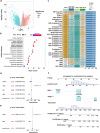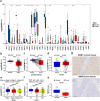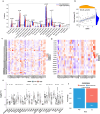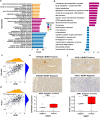Identification of methionine metabolism related prognostic model and tumor suppressive functions of BHMT in hepatocellular carcinoma
- PMID: 40102459
- PMCID: PMC11920202
- DOI: 10.1038/s41598-025-93650-w
Identification of methionine metabolism related prognostic model and tumor suppressive functions of BHMT in hepatocellular carcinoma
Abstract
Given the resistance to conventional treatments and limitations of immune checkpoint blockade therapy in hepatocellular carcinoma (HCC), it is imperative to explore novel prognostic models and biomarkers. The dependence of cancer cell on exogenous methionine, known as Hoffman effect, is a hallmark of HCC, with numerous studies reporting a strong correlation between methionine metabolism and tumor development. Betaine-homocysteine S-methyltransferase (BHMT), a critical component of methionine metabolism pathway, has polymorphisms linking to poor prognosis in multiple cancers. Nevertheless, there is little literature regarding the relationship between methionine metabolism and incidence, mortality of HCC, as well as the function of BHMT in HCC progression. In this study, by analyzing multiple datasets, we constructed a methionine metabolism-related prognostic model and thoroughly investigated the influence of BHMT on the prognosis of HCC. Bioinformatics analysis revealed a marked decrease in BHMT expression in HCC, which was linked to adverse clinical outcomes. CIBERSORT results suggest that BHMT promotes infiltration of M1 macrophages. Our results suggest its potential as an ideal prognostic biomarker for anti PD-L1 immunotherapy. In summary, this study innovatively provides first methionine metabolism-related prognostic model and unveils the tumor suppressive function of BHMT in HCC, providing potential mechanism by which BHMT exert its function.
Keywords: BHMT; Hepatocellular carcinoma; Immunotherapy; Lipid metabolism; Methionine metabolism; Tumor microenvironment.
© 2025. The Author(s).
Conflict of interest statement
Declarations. Competing interests: The authors declare no competing interests.
Figures







Similar articles
-
Downregulation of betaine homocysteine methyltransferase (BHMT) in hepatocellular carcinoma associates with poor prognosis.Tumour Biol. 2016 May;37(5):5911-7. doi: 10.1007/s13277-015-4443-6. Epub 2015 Nov 23. Tumour Biol. 2016. PMID: 26592251
-
A splicing variant leads to complete loss of function of betaine-homocysteine methyltransferase (BHMT) gene in hepatocellular carcinoma.Int J Biochem Cell Biol. 2012 Feb;44(2):385-92. doi: 10.1016/j.biocel.2011.11.014. Epub 2011 Nov 26. Int J Biochem Cell Biol. 2012. PMID: 22138536
-
Betaine homocysteine methyltransferase (BHMT)-dependent remethylation pathway in human healthy and tumoral liver.Clin Chem Lab Med. 2013 Mar 1;51(3):617-21. doi: 10.1515/cclm-2012-0689. Clin Chem Lab Med. 2013. PMID: 23449526 Review.
-
Deletion of betaine-homocysteine S-methyltransferase in mice perturbs choline and 1-carbon metabolism, resulting in fatty liver and hepatocellular carcinomas.J Biol Chem. 2011 Oct 21;286(42):36258-67. doi: 10.1074/jbc.M111.265348. Epub 2011 Aug 30. J Biol Chem. 2011. PMID: 21878621 Free PMC article.
-
Pleiotropic effects of methionine adenosyltransferases deregulation as determinants of liver cancer progression and prognosis.J Hepatol. 2013 Oct;59(4):830-41. doi: 10.1016/j.jhep.2013.04.031. Epub 2013 May 7. J Hepatol. 2013. PMID: 23665184 Review.
References
-
- Torimura, T. & Iwamoto, H. Treatment and the prognosis of hepatocellular carcinoma in Asia. Liver Int.42, 2042–2054. 10.1111/liv.15130 (2022). - PubMed
-
- Bray, F. et al. Global cancer statistics 2022: GLOBOCAN estimates of incidence and mortality worldwide for 36 cancers in 185 countries. CA Cancer J. Clin.74, 229–263. 10.3322/caac.21834 (2024). - PubMed
-
- Yang, J. D. & Heimbach, J. K. New advances in the diagnosis and management of hepatocellular carcinoma. BMJ371, m3544. 10.1136/bmj.m3544 (2020). - PubMed
-
- Jiang, Y. et al. Proteomics identifies new therapeutic targets of early-stage hepatocellular carcinoma. Nature567, 257–261. 10.1038/s41586-019-0987-8 (2019). - PubMed
MeSH terms
Substances
Grants and funding
LinkOut - more resources
Full Text Sources
Medical
Research Materials
Miscellaneous

